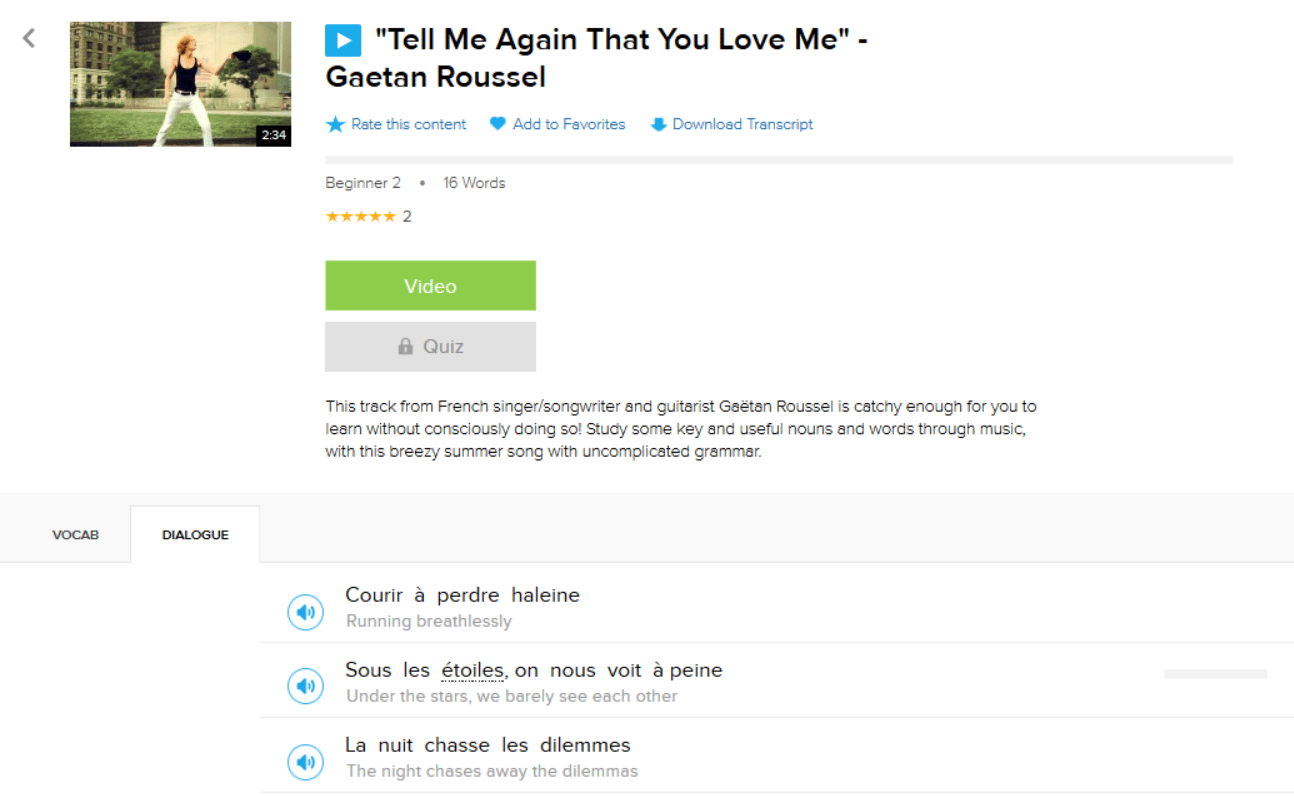Contents
- So, What Makes a French Adjective Irregular?
- The 4 Types of French Irregular Adjectives
- And one more thing...
French Irregular Adjectives

For every rule, there’s an exception.
As a French learner, you probably realize (or will soon realize!) that this describes the French language to a T.
You’ll find exceptions in French song lyrics, while learning new vocabulary and in some of the most commonly used verbs.
As you learn and use more and more adjectives, you’ll continue to find… you guessed it, exceptions.
In this post, I’ll teach you all about the four different types of French irregular adjectives. You’ll also find some useful practice resources at the end of this post!
Download: This blog post is available as a convenient and portable PDF that you can take anywhere. Click here to get a copy. (Download)
So, What Makes a French Adjective Irregular?
French is a language that’s all about agreement. So adjectives in French must reflect the gender and the quantity of the noun to which they refer.
Normally, making adjectives agree with their subject follows a regular pattern that revolves around the masculine singular adjectival form:
- The addition of an “s” makes a regular adjective masculine and plural.
- Adding an “e” to a masculine singular adjective makes it feminine.
- The addition of “es” makes an adjective plural and feminine.
Here’s an example with the adjective chaud (hot), which is used to modify singular and masculine nouns:
Le four est chaud. (The oven is hot.)
To make chaud masculine plural we simply add an “s”:
Les fours sont chauds. (The ovens are hot.)
To make chaud feminine singular, we simply add an “e” to the masculine singular, which gives us:
L’eau est chaude. (The water is hot.)
And finally, to make it feminine plural, we add “es”:
Les pizzas sont chaudes. (The pizzas are hot.)
So that’s the regular pattern. Irregular adjectives, on the other hand, move to the beat of their own drum. Let’s take a look, shall we?
The 4 Types of French Irregular Adjectives
Generally speaking, irregular adjectives can be broken up into four broad categories:
| Types of Irregular French Adjectives |
|---|
| 1. Adjectives that follow a discernible pattern according to their masculine endings. |
| 2. Adjectives whose form changes completely between the masculine and the feminine. |
| 3. Adjectives that remain the same regardless of the gender of the nouns they modify. |
| 4. Adjectives that are invariable. These have a single form and they don't agree with the quantity or gender of the nouns with which they're used. |
On y va ! (Let’s go!)
1. Irregular adjectives with a discernible pattern according to masculine endings
Let’s look at how this type of adjective works with various endings.
-el becomes -elle
Marc est cruel, donc il n’a pas de copine. (Marc is cruel, therefore he does not have a girlfriend.)
Elise est cruelle, donc elle n’a pas de compagnon. (Elise is cruel, therefore she does not have a boyfriend.)
-eil becomes -eille
Il faut que je trouve un fauteuil pareil. (I have to find a similar couch.)
Je n’ai jamais rencontré une fille pareille ! (I’ve never met a girl like her!)
-il becomes -ille
Sois gentil, Michel ! (Be nice, Michel!)
Sois gentille avec le chien, Alice ! (Be nice to the dog, Alice!)
-on becomes -onne
Le chiot de Manon est mignon ! (Manon’s puppy is cute!)
La fille d’Anna et Serge est mignonne. (Serge and Anna’s daughter is cute.)
-s becomes -sse
Mon chien est trop gros ; je dois lui donner moins de croquettes. (My dog is too fat; I have to give him less kibble.)
J’ai une grosse voiture. (I have a huge car.)
-en becomes -enne
Son père est un ancien combattant. (His father is a former soldier.)
Sa mère est une ancienne institutrice. (His mother is a former primary school teacher.)
-et becomes -ète
Michel est inquiet. Il n’arrive pas à manger. (Michel is worried. He can’t eat.)
Manon est inquiète. Elle n’arrive pas à dormir. (Manon is worried. She can’t sleep.)
-er becomes -ère
Ce manteau est très cher. (This coat is very expensive.)
Cette robe est très chère. (This dress is very expensive.)
-eur becomes -euse
Michel est rêveur. (Michel is a dreamer.)
Sandrine est rêveuse. (Sandrine is a dreamer.)
-teur becomes -trice
Mon père est très protecteur. (My father is very protective.)
Ma mère est très protectrice. (My mother is very protective.)
-f becomes -ive
Jean-Bernard est sportif. Il court tous les jours. (Jean-Bernard is athletic. He runs every day.)
Aurélie est sportive. Elle nage tous les jours. (Aurélie is athletic. She swims every day.)
-c becomes -che
Carole porte un pantalon blanc. (Carole is wearing white pants.)
Brigitte porte une robe blanche. (Brigitte is wearing a white dress.)
-ou becomes -olle
Tu es fou, Jean ! (You’re crazy, Jean!)
Elle est folle. Elle fait trop la fête ! (She is crazy. She parties too much!)
Further irregularity: Fol is the singular masculine form of fou (crazy) that’s used before singular masculine nouns starting with a vowel or h muet (unaspirated “h”), as in:
Jean est un fol homme. (Jean is a crazy man.)
In all of the above cases, the plural form is quite simple: You just add an “s.” Let’s continue with the example of fou:
The masculine plural is fous :
Jean et Marc sont fous. (Jean and Marc are crazy.)
The feminine plural is folles :
Elles sont folles. (They are crazy.)
An exception to the plural rule occurs when the masculine singular form of the adjective ends in an “x,” in which case the plural form is exactly the same as the masculine singular. A prime example of this occurs with masculine singular adjectives that end in -eux.
François est heureux. (François is happy.)
François et Nicolas sont heureux. (François and Nicolas are happy.)
The feminine singular ending becomes -euse:
Françoise est heureuse. (Françoise is happy.)
For the feminine plural form, we add an “s” to the feminine singular form:
Françoise et Sarah sont heureuses. (Françoise and Sarah are happy.)
This rule also applies quite often to the adjectives below. Onward!
2. Adjectives that change completely according to their gender
Some adjectives have masculine and feminine forms that are completely different from each other. Let’s take a look at some examples of these that you’re bound to come across often.
Beau
Beau is the masculine singular for “handsome.” In the feminine singular form, we use belle (beautiful). The masculine plural is beaux and the feminine plural is belles .
Michel est beau. (Michel is handsome.)
Michel et Jean-Bernard sont beaux. (Michel and Jean-Bernard are handsome.)
Mireille est belle. (Mireille is beautiful.)
Mireille et Sarah sont belles. (Mireille and Sarah are beautiful.)
Further irregularity: Bel is the singular masculine form of beau that’s used before singular masculine nouns starting with a vowel or h muet, as in:
Jean est un bel homme. (Jean is a handsome man.)
Doux
Doux, which is masculine singular for “soft” or “sweet,” becomes douce when used with feminine singular nouns. The masculine plural is doux . (Yes, it’s the same as the masculine singular! Remember what I said about adjectives that end with “x.”) The feminine plural form is douces .
Mon chien a un poil doux. (My dog has a soft coat.)
Les draps sont doux. (The bedsheets are soft.)
Marie a une voix douce. (Marie has a sweet voice.)
Faux
Faux means “false” or “fake” and it’s used in conjunction with masculine singular nouns. For feminine singular nouns we use fausse . The masculine plural is faux (again, it’s the same as the masculine singular!) and we use fausses to refer to feminine plural nouns.
Le rapport de police est faux. (The police report is false.)
Les bijoux de Marie sont faux. (Marie’s jewelry is fake.)
L’hypothèse est fausse. (The hypothesis is false.)
Les allégations sont fausses. (The allegations are false.)
Favori
Favori, which means—you guessed it—“favorite,” is a masculine singular adjective. In the company of feminine singular nouns we use favorite . The masculine plural is favoris and the feminine plural is favorites . We just add an “s” in both cases.
Mon sport favori est le tennis. (My favorite sport is tennis.)
Mes sports favoris sont le tennis et le golf. (My favorite sports are tennis and golf.)
L’activité favorite d’Antonin est le coloriage. (Antonin’s favorite activity is coloring.)
Les activités favorites de Claire sont la lecture et la natation. (Claire’s favorite activities are reading and swimming.)
Frais
Frais means “fresh” or “cool” and we use it with masculine singular nouns. To refer to feminine singular nouns we use fraîche . The masculine plural is the same as the masculine singular: frais. Like masculine singular adjectives that end in “x,” those that end in “s” have the same singular and plural adjectival form. In the company of feminine plural nouns, we use fraîches .
Le vent est frais. (The wind is cool.)
Les légumes sont frais. (The vegetables are fresh.)
L’eau est fraîche. (The water is fresh/cool.)
Les tomates sont fraîches. (The tomatoes are fresh.)
Long
Long means “long” and it’s used to modify masculine singular nouns. Longue is used to modify feminine singular nouns. We add an “s” to the masculine singular to get longs . The feminine plural form is longues .
Le livre est long. (The book is long.)
Les cheveux de Sarah sont longs. (Sarah’s hair is long.)
L’histoire est longue. (The story is long.)
Michel porte une chemise à manches longues. (Michel is wearing a long-sleeved dress shirt.)
Nouveau
Nouveau, which means “new,” is used with masculine singular nouns, and nouvelle is the feminine singular form of the adjective. For masculine plural, we add an “x” to the masculine singular to get nouveaux and for the feminine plural we simply add an “s” to the feminine singular, leaving us with nouvelles .
Dany Boon a un nouveau film. (Dany Boon has a new film.)
Marie a une nouvelle voiture. (Marie has a new car.)
Michel a de nouveaux livres. (Michel has some new books.)
Michel a de nouvelles chaussures. (Michel has new shoes.)
Further irregularity: Nouvel is the singular masculine form of nouveaux that’s used before singular masculine nouns starting with a vowel or h muet, as in:
Le nouvel hôpital a trois étages. (The new hospital has three floors.)
Public
Public means “public” and refers to masculine singular nouns, while publique refers to feminine singular nouns. The masculine plural form is publics and the feminine singular form is publiques .
L’établissement est public. (The establishment is public.)
L’école est publique. (The school is public.)
Les établissements sont publics. (The establishments are public.)
Les écoles sont publiques. (The schools are public.)
Vieux
Vieux, which means “old,” is used with masculine singular nouns and vieille is the feminine singular form of the adjective. The masculine plural form of the adjective is the same as the masculine singular, vieux. For the feminine plural, we add an “s” to get vieilles .
Le grand-père de Martin est vieux. (Martin’s grandfather is old.)
Les grand-parents de Martin sont vieux. (Martin’s grandparents are old.)
La grand-mère de Nicolas est vieille. (Nicolas’ grandmother is old.)
Les tantes de Nicolas sont vieilles. (Nicolas’ aunts are old.)
Further irregularity: Vieil is the singular masculine form of vieux (old) that’s used before singular masculine nouns starting with a vowel or h muet, as in:
Le vieil homme est mon voisin. (The old man is my neighbor.)
3. Adjectives that remain the same in their masculine and feminine forms
Some adjectives remain the same, regardless of whether they’re modifying masculine or feminine nouns. It’s worth noticing that these adjectives end in “e.” When referring to a noun in the plural form, you simply add an “s.” Facile (easy)!
Here’s a list of some common adjectives that you’ll run into where this is the case:
| French | English |
|---|---|
| calme | calm |
| difficile | difficult |
| facile | easy |
| imaginaire | imaginary |
| ironique | ironic |
| mince | slim |
| minuscule | minuscule |
| pauvre | poor |
| propre | clean |
| ridicule | ridiculous |
| semblable | similar |
| sensible | sensitive |
| sympathique | nice |
4. Invariable adjectives
Color adjectives whose names are derived from the names of animals, flowers, fruits and metals are usually invariable.
Here’s a list of those you’re bound to come across:
| French | English |
|---|---|
| ardoise | slate grey |
| argent | silver |
| aubergine | eggplant |
| brique | brick red |
| canari | canary yellow |
| caramel | caramel-colored |
| chair | flesh-colored |
| kaki | khaki, which in French is olive green |
| lavande | lavender |
| marine | navy blue |
| marron | brown |
| orange | orange |
| pastel | pastel |
| pistache | pistachio-green |
| platine | platinum |
| sable | sandy, sand-colored |
| safran | saffron-colored |
| saumon | salmon-pink |
| turquoise | turquoise |
Adjectives that are borrowed from other languages (English and Arabic, for example) are usually invariable, but don’t be surprised if you sometimes see them agreeing with their associated nouns. Here are some notable ones:
| French | English |
|---|---|
| ad hoc | ad hoc |
| a priori | a priori |
| cheap | poor quality |
| clean | clean, honest |
| cool | cool |
| fun | fun |
| glamour | glamorous |
| halal | halal |
| hi-fi | hi-fi |
| high-tech | high-tech |
| kif-kif | same, identical |
| lambda | average, typical |
| light | light, low in calories |
| relax | relaxed, informal, laid back |
| select | select, high-class, posh |
| trash | tasteless |
| top | great |
As you’ve probably gathered from your French learning journey thus far, practice is a must.
For drilling French irregular adjectives into your brain, reference books and quizzes are a great combination.

Along with this 12-question fill-in-the blank exercise, Quizlet is a great resource for quizzing yourself on irregular adjective endings as well as noun-adjective agreement. I recommend this quiz followed by this more difficult one to get started.
But the best way to get the hang of irregular adjectives is to make them a part of your regular French routine by watching and listening to them. For example, you could watch a French movie or listen for them on an immersive language learning program like FluentU.
FluentU takes authentic videos—like music videos, movie trailers, news and inspiring talks—and turns them into personalized language learning lessons.
You can try FluentU for free for 2 weeks. Check out the website or download the iOS app or Android app.
P.S. Click here to take advantage of our current sale! (Expires at the end of this month.)
Now that you’ve seen the different types of French irregular adjectives, you’re ready to start using them!
Download: This blog post is available as a convenient and portable PDF that you can take anywhere. Click here to get a copy. (Download)
And one more thing...
If you like learning French on your own time and from the comfort of your smart device, then I'd be remiss to not tell you about FluentU.
FluentU has a wide variety of great content, like interviews, documentary excerpts and web series, as you can see here:

FluentU brings native French videos with reach. With interactive captions, you can tap on any word to see an image, definition and useful examples.

For example, if you tap on the word "crois," you'll see this:

Practice and reinforce all the vocabulary you've learned in a given video with learn mode. Swipe left or right to see more examples for the word you’re learning, and play the mini-games found in our dynamic flashcards, like "fill in the blank."

All throughout, FluentU tracks the vocabulary that you’re learning and uses this information to give you a totally personalized experience. It gives you extra practice with difficult words—and reminds you when it’s time to review what you’ve learned.
Start using the FluentU website on your computer or tablet or, better yet, download the FluentU app from the iTunes or Google Play store. Click here to take advantage of our current sale! (Expires at the end of this month.)








